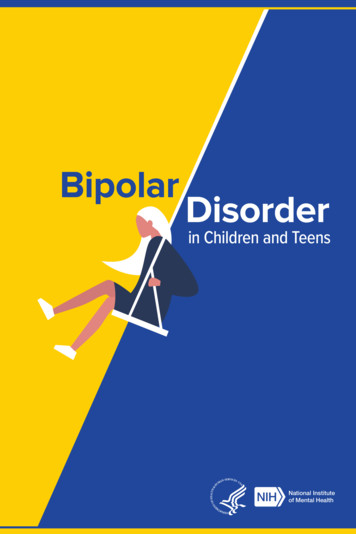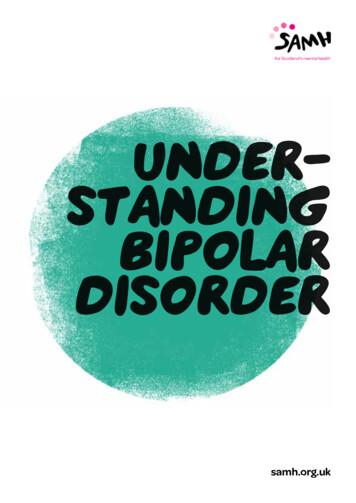Bipolar Disorder - Screening And Diagnosing In Primary Care
UW PACC Psychiatry and Addictions Case Conference UW Medicine Psychiatry and Behavioral Sciences BIPOLAR DISORDER – SCREENING AND DIAGNOSING IN PRIMARY CARE JOSEPH CERIMELE MD MPH UNIVERSITY OF WASHINGTON UW PACC 2018 University of Washington
GENERAL DISCLOSURES The University of Washington School of Medicine also gratefully acknowledges receipt of educational grant support for this activity from the Washington State Legislature through the Safety-Net Hospital Assessment, working to expand access to psychiatric services throughout Washington State. UW PACC 2018 University of Washington
OBJECTIVES 1. Describe the clinical epidemiology of individuals w bipolar disorder in primary care settings 2. Describe techniques to improve the recognition of bipolar disorder in primary care patients 3. Describe clinical characteristics of patients with bipolar disorder in primary care UW PACC 2018 University of Washington
SPEAKER DISCLOSURES Any conflicts of interest? None UW PACC 2018 University of Washington
WHAT IS BIPOLAR DISORDER? Episodic, and often chronic, depressive symptoms. Less frequent hypomanic or manic symptoms and episodes Belmaker RH. N Engl J Med 2004;351:476-486 UW PACC 2018 University of Washington
ISN’T BIPOLAR DISORDER A SPECIALTY ILLNESS? Intermittent specialty care Some individuals receive care exclusively in primary care Those dx w bipolar disorder often experience depression and most patients with depression present to primary care UW PACC 2018 University of Washington
PREVALENCE - GENERAL POPULATION UW PACC 2018 University of Washington
PREVALENCE – PRIMARY CARE Summary : Twice the prevalence – Based on structured interview – Screening measure over-estimated prevalence by 2-3x Specifics: – Higher prevalence in FQHCs or safety net settings – Elevated prevalence in individuals presenting with psychiatric symptom – Positive screen on MDQ is not equivalent to diagnosis UW PACC 2018 University of Washington
Bipolar I Disorder 35% Bipolar II Disorder 26% Subthreshold Bipolar Disorder 8% 28% 34% 21% 33% 34% 63% Psychiatrist General Medical No Treatment Adapted from: Merikangas, et al.1 in Arch Gen Psychiatry. 2007;64(5):543-552 The proportion of individuals with bipolar I disorder, bipolar II disorder or subthreshold bipolar disorder receiving treatment from a psychiatrist, general medical clinician, or no treatment in the past 12 months UW PACC 2018 University of Washington
DIAGNOSIS IS DIFFICULT IN ANY SETTING Often seems like there isn’t enough information Uncertainty about accuracy of past diagnoses Clinicians try to balance uncertainty with knowing that many individuals with bipolar disorder go 8 yrs without accurate diagnosis How do you manage diagnostic uncertainty? UW PACC 2018 University of Washington
IMPROVING ACCURACY OF DIAGNOSIS Screening in primary care with commonly used measure the Mood Disorder Questionnaire over-estimates prevalence by 23x. – Majority of primary care patients with positive screen on MDQ do not have bipolar disorder UW PACC 2018 University of Washington
CLINICAL CHARACTERISTICS Summary: High symptom severity, High psychosocial impairment Specifics: 1. High burden of depressive symptoms measured by PHQ9 (mean 18) 2. Majority had past specialty mental health care; 1/3 had prior hospitalization 3. 15% homeless, 25% lack of support person, 33% lack of depen. transportation 4. 30% of patients experienced significant reduction in depression (PHQ9 10) 5. 25% of patients were referred from primary to specialty mental health care UW PACC 2018 University of Washington
CLINICAL FEATURES UW PACC 2018 University of Washington
Majority of individuals with bipolar depression experience 1 or more concurrent manic symptom Goldberg JF, et al. Am J Psychiatry. 2009;166:173-181 UW PACC 2018 University of Washington
COULD USE STRUCTURED INTERVIEW QUESTIONS We used the CIDI measure Also could use follow-up questions Could curbside psychiatrist if available UW PACC 2018 University of Washington
DEFINE THE TIME PERIOD Change in Mood (irritable or euphoric) and/or Energy (increased or restless)? When did that happen and was it for several days at least? When that happened did other things occur? UW PACC 2018 University of Washington
UW PACC 2018 University of Washington
UW PACC 2018 University of Washington
Question Reasoning How long do the hypomanic/manic episodes last (hours/days/weeks/months)? Few hours or more -alternate disorder. A few days or greater - hypomanic or manic episode. How frequently do the hypomanic/manic episodes occur (e.g., how many times a year)? Episodes occurring several times a week or even weekly are not characteristic of bipolar disorder. Have the hypomanic/manic episodes occurred only when drugs were being used? Episodes only occurring during substance use may be more indicative of a substance induced mood disorder. How many depressive episodes have occurred to date (e.g., just a few e.g. 4, or very many)? Patients with a high number of depressive episodes are more likely to have bipolar disorder. Do you have a family history of bipolar disorder ? Positive family history increases risk Have you been previously diagnosed with bipolar disorder, and if so, by whom? Was it by a clinician? Have you previously been treated with antidepressants, and if so, how did you respond Patients with bipolar disorder may experience increased energy, sleep problems or emotional lability At what age did the mood episodes begin? Bipolar disorder usually has an earlier age UW PACC of onset than major depressive disorder. 2018 University of Washington
Subthreshold Bipolar. Disorder. Bipolar II Disorder. Bipolar I Disorder. Psychiatrist. General Medical. No Treatment. Adapted from: Merikangas, et al.1 in Arch Gen Psychiatry. 2007;64(5):543552- The proportion of individuals with bipolar I disorder, bipolar II disorder or subthreshold bipolar disorder
3. Understanding the Term 'Bipolar Disorder' 4. The Possible Causes of Bipolar Disorder 5. 5 The Feelings an Individual May Have When Experiencing Bipolar Disorder 6. An Individual's Bipolar Disorder and How It May Affect Others 7. The Demands of Daily Life That May Influence Symptoms of Bipolar Disorder 8.
Some children and teens with these symptoms may have . bipolar disorder, a brain disorder that causes unusual shifts in mood, energy, activity levels, and day-to-day functioning. With treatment, children and teens with bipolar disorder can get better over time. What is bipolar disorder? Bipolar disorder is a mental disorder that causes people to experience . noticeable, sometimes extreme .
What is bipolar disorder? Bipolar disorder is a mental health problem that mainly affects your mood. If you have bipolar disorder, you are likely to have times where you experience: manic or hypomanic episodes (feeling high) depressive episodes (feeling low) potentially some psychotic symptoms during manic or depressed episodes
the neurobiology of bipolar disorder. A further aim was to draw attention to new ther-apeutic targets in the treatmen t of bipolar disorder. To accomplish these goals, an elec-tronic search was undertaken of the PubMed database in August 2015 of literature pub-lished during the last 10 years on the path ophysiology of bipolar disorder. A wide-rang-
Bipolar disorder is a chronic or episodic (which means occurring occasionally and at irregular intervals) mental disorder. It can cause unusual, often extreme and fluctuating changes in mood, energy, activity, and concentration or focus. Bipolar disorder sometimes is called manic-depressive disorder or manic
9417 Depersonalization disorder SOMATOFORM DISORDERS 9421 Somatization disorder 9422 Pain disorder 9423 Undifferentiated somatoform disorder 9424 Conversion disorder 9425 Hypochondriasis MOOD DISORDERS 9431 Cyclothymic disorder 9432 Bipolar disorder 9433 Dysthymic disorder 9434 Major depres
Autism Spectrum Disorder What You Can Do Right Now to Help Your Child with Autism. Jonathan Levy Autism Spectrum Disorder Your Child's Health Growth and the Signs of Autism. OAR Bipolar Bipolar Child. Demitri Papolos, M.D. and Janice Papolos Bipolar Living Well with Depression and Bipolar Disorder: What Your Doctor Doesn't Tell You that You .
Biology 1413 Introductory Zoology – 4Supplement to Lab Manual; Ziser 2015.12 Lab Reports Each student will complete a Lab Report (see Table of Contents)for the material covered in each of 4 Lab Practicals. Lab reports are at the end of each section of material for each practical (see Table of Contents).























